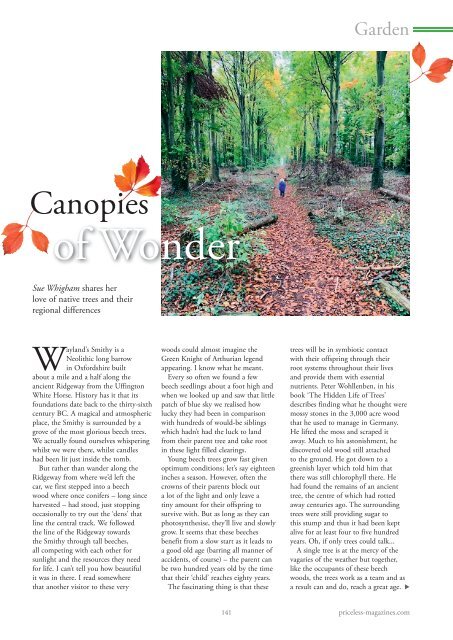Wealden Times | WT224 | Nov & Dec 2020 | Christmas supplement inside
Wealden Times - The lifestyle magazine for the Weald
Wealden Times - The lifestyle magazine for the Weald
Create successful ePaper yourself
Turn your PDF publications into a flip-book with our unique Google optimized e-Paper software.
Garden<br />
Canopies<br />
of Wonder<br />
Sue Whigham shares her<br />
love of native trees and their<br />
regional differences<br />
Wayland’s Smithy is a<br />
Neolithic long barrow<br />
in Oxfordshire built<br />
about a mile and a half along the<br />
ancient Ridgeway from the Uffington<br />
White Horse. History has it that its<br />
foundations date back to the thirty-sixth<br />
century BC. A magical and atmospheric<br />
place, the Smithy is surrounded by a<br />
grove of the most glorious beech trees.<br />
We actually found ourselves whispering<br />
whilst we were there, whilst candles<br />
had been lit just <strong>inside</strong> the tomb.<br />
But rather than wander along the<br />
Ridgeway from where we’d left the<br />
car, we first stepped into a beech<br />
wood where once conifers – long since<br />
harvested – had stood, just stopping<br />
occasionally to try out the ‘dens’ that<br />
line the central track. We followed<br />
the line of the Ridgeway towards<br />
the Smithy through tall beeches,<br />
all competing with each other for<br />
sunlight and the resources they need<br />
for life. I can’t tell you how beautiful<br />
it was in there. I read somewhere<br />
that another visitor to these very<br />
woods could almost imagine the<br />
Green Knight of Arthurian legend<br />
appearing. I know what he meant.<br />
Every so often we found a few<br />
beech seedlings about a foot high and<br />
when we looked up and saw that little<br />
patch of blue sky we realised how<br />
lucky they had been in comparison<br />
with hundreds of would-be siblings<br />
which hadn’t had the luck to land<br />
from their parent tree and take root<br />
in these light filled clearings.<br />
Young beech trees grow fast given<br />
optimum conditions; let’s say eighteen<br />
inches a season. However, often the<br />
crowns of their parents block out<br />
a lot of the light and only leave a<br />
tiny amount for their offspring to<br />
survive with. But as long as they can<br />
photosynthesise, they’ll live and slowly<br />
grow. It seems that these beeches<br />
benefit from a slow start as it leads to<br />
a good old age (barring all manner of<br />
accidents, of course) – the parent can<br />
be two hundred years old by the time<br />
that their ‘child’ reaches eighty years.<br />
The fascinating thing is that these<br />
trees will be in symbiotic contact<br />
with their offspring through their<br />
root systems throughout their lives<br />
and provide them with essential<br />
nutrients. Peter Wohllenben, in his<br />
book ‘The Hidden Life of Trees’<br />
describes finding what he thought were<br />
mossy stones in the 3,000 acre wood<br />
that he used to manage in Germany.<br />
He lifted the moss and scraped it<br />
away. Much to his astonishment, he<br />
discovered old wood still attached<br />
to the ground. He got down to a<br />
greenish layer which told him that<br />
there was still chlorophyll there. He<br />
had found the remains of an ancient<br />
tree, the centre of which had rotted<br />
away centuries ago. The surrounding<br />
trees were still providing sugar to<br />
this stump and thus it had been kept<br />
alive for at least four to five hundred<br />
years. Oh, if only trees could talk...<br />
A single tree is at the mercy of the<br />
vagaries of the weather but together,<br />
like the occupants of these beech<br />
woods, the trees work as a team and as<br />
a result can and do, reach a great age. <br />
141 priceless-magazines.com


















